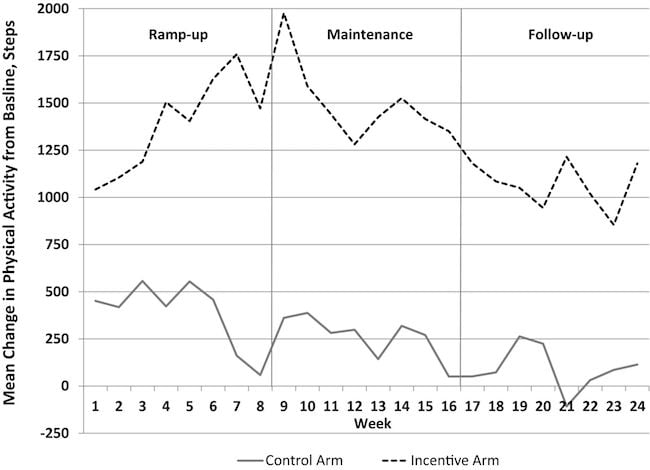Employee wellness programs often provide participants with financial incentives, such as cash, the ability to set personal goals, or wearable devices for tracking activity. Unfortunately, many employee wellness programs do not include all three of these elements together. New research from the Journal of the American Heart Association may change employers’ views on how they build wellness programs. The study suggests that loss‐framed financial incentives with personalized goal setting will significantly increase physical activity among wellness program participants using wearable devices.
The study took place over 24 weeks and included 105 patients with ischemic heart disease. The intervention group was given a Misfit wearable tracker, personalized step goals, and daily feedback, as well as $14 a week for the first 16-weeks. If a participant didn’t meet their step goal each day they were deducted $2 a day. Patients in the control group received an activity wearable and were tasked with the standardized goal of reaching 10,000 steps a day. All participants were given a two-week startup period to establish baseline step counts and $50 just for completing enrollment and the trial.

During the initial eight-week ramp up period, the intervention group’s daily steps increased from the baseline by 1,388 steps. The control group experienced a 385 step increase over the same period. The intervention group’s step count remained high during the maintenance period (weeks nine through 16) with an increase of 1,501 steps from baseline (vs. 264 for the control group). Researchers saw results even after the incentives concluded. During the final eight weeks of the study, which was the follow-up period and included no incentives, the intervention participants continued to have on average 1,066 more steps from baseline while the control group only had a mean of 92 more steps than baseline.
Framing rewards as a loss — a technique from behavioral economics — led to a meaningful difference in behavior. During the 6-month trial, the average patient in the intervention arm had step counts that totaled about 100 miles more than the average patient in control.
– Dr. Mitesh Patel, Assistant Professor of Medicine and Health Care Management
One unique element of this program that employers should pay particular attention to is the loss-framed incentive structure. Most wellness programs, including many of the ones operated by Wellable, provide incentives for completing certain activities or achieving certain goals. As seen in other studies, including this one, providing the reward upfront and taking it away for not hitting certain milestones may be a better strategy to drive engagement and results. Loss-framed incentives may be more effective because of a behavioral economics principle known as loss aversion. Loss aversion refers to people’s tendency to prefer avoiding losses to acquiring equivalent gains. In other words, framing the incentive as a loss (losing $14 per week vs. earning $14 per week) may result in better wellness program outcomes. Despite the research, most employers do not employ this principle of behavioral economics in their programs.
The researchers did note that there were several limitations to the investigation, including the patients were all from four hospitals in southern Pennsylvania, the study only evaluating physical activity based on steps, and the control group having slightly more missing data points than the intervention group.
This is one of the first clinical trials that used financial incentives and found increases in physical activity were sustained even after incentives stopped, a potential sign of habit formation.
– Dr. Mitesh Patel, Assistant Professor of Medicine and Health Care Management












